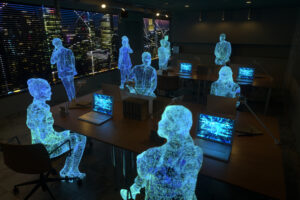
Earlier this year, we told you that there’s nothing special about event apps. While that’s a conviction that we here at Eventsforce still certainly stand by, we also recognise that this absolute view doesn’t leave a lot of room for contemplation, consideration, or — most importantly — the opportunity to give a voice to some of those fundamental burning questions that you, as an event planner, might still have about event apps.
Let’s face it: putting your hand up can be scary, so let us take some of that fear away. By popular demand, we’re taking a second pass on the subject, creating a safe space in which to address absolutely everything you wanted to know about event apps — the good, the bad and the downright ugly — but were just too afraid to ask.
Question 1: Everyone Seems to Have One These Days, But I Still Don’t Get It. What’s So Good About Event Apps?
An honest question — one that likewise deserves an honest answer:
If you think of your event as a long chain — one in which you, a planner, are closely connected to both your attendees and your stakeholders — a carefully selected event app offers something positive to all links on that chain. For attendees and delegates, an event app could mean any number of great things — whether the chance to forge connections, the opportunity to independently organise their time during an occasion or even a way of staying informed and engaged throughout the course of an event, etc.
For planners, the use of an app not only represents a way to enhance the attendee experience before, during and after an event, but serves as the perfect vehicle for the level of personalisation and customisation that planners need to deploy in order to engage with their audience. And as for stakeholders — those parties who are vested in your event, yet who might be far removed from its finer details — an event app plays directly into the need to reduce costs and collect and analyse data, all with a view to building future event success.
Question 2: Sounds Great. What Could Possibly Go Wrong? Bring On The Bad Bits.
Well, from a planner’s perspective, the addition of an app isn’t just another way to enhance the occasion, but something that could add another layer of complexity to an event that already has multiple moving parts. Here are some points to consider:
Decide in haste, regret at leisure. We know that operating at speed is an intrinsic part of being an event planner, but really, this is an example of an instance where an overly quick decision could result in a poor experience for your attendees and for you. Slow down and consider what you actually need or want from your app before you take the plunge.
Cost — in time and money. Absolutely, apps can bring so much to an event, but they aren’t always cheap or quick to develop. This is especially the case for a bespoke event app, which can take months of planning, development and testing before it’s finally implemented. As an aside, it’s also worth pointing out that off-the-shelf event apps — while they might initially seem to be more cost-effective — may provide fewer customisation options but still require subscription fees or licensing costs, which can be prohibitive if your budget is tight.
Working out the kinks demands your full attention (and more time!). Following on from the initial development and implementation of your app, you’ll also need to ensure that you test it across a wide variety of devices, taking great care to work out any bugs and glitches, all the while paying special attention to loading times across various systems. And finally, it’s worth considering one very obvious point: if you want to run your event solely via an app, ensure that your chosen venue has enough charging stations to accommodate the number of people you’re expecting at your event.
Due Diligence with Data. All that data generated by your app is great, right? Absolutely! Just remember that not only do all of your attendees expect their personal details to be safeguarded, but that you, as a planner, have a legal obligation to do so. Failing to protect this information can lead to data breaches. These not only have the potential to damage your event’s reputation in the short-term, but could have serious legal consequences for your organisation in the long-run. As the person responsible for your event app, you must ensure that it is secure, encrypted and compliant with any data protection framework.
Question 3: OK, I’m Ready. What About The Ugly Stuff?
Here we go: the ugly bits. Let’s frame this part of the discussion by conjuring up an event planner’s worst nightmare: a disengaged audience.
“I’ve got an event app; I’m good,” we hear you say. We don’t want to put too fine a point on it, but this — after all — is a no-holds-barred discussion, so let’s get this over with:
Scenario 1: You’ve got an app, but your attendees can’t — or won’t — use it.
This first scenario is a veritable kaleidoscope of frustration, with every iteration on the theme eliciting one headache after another. So, let’s say you’ve built (or selected) a beautiful app, but you’ve neglected to consider the following simple fact: not all of your attendees have access to the latest smartphone technology, which underpins the functionality of your chosen event app. These attendees are essentially locked out of your event, leaving them (and you) completely disengaged and frustrated.
In another twist on this scenario, you’ve overwhelmed your attendees with an event app that’s so crammed with excessive features and functionality that they just don’t want to use it. The lesson here is to keep things simple and stick only to the level of functionality that your attendees will use. You want an app that prioritises key information, offers intuitive navigation and promotes effortless engagement.
Finally, you’ve got the “lead a horse to water” situation. You’ve done it all — implemented an app that’s accessible for all attendees, one that’s simple to use — and yet, people just aren’t downloading and using it. Why? We don’t know, but we agree: it’s hard to engage with an audience via an event app if they just won’t use an event app. It happens. You might, however, consider helping your attendees along by creating a short ‘how-to’ video, something that very quickly guides them through both how to download and use your app. As an example, here’s a short video we created for the Simpleview EMEA Summit app, powered by Eventsforce.
Scenario 2: You’ve got an app, but no back-up plan.
If an app can elevate an event, then it certainly has the capacity to bring it down. We are speaking of the unspeakable: crashes and outages. They do happen, they can certainly disrupt the engagement that you’ve worked so very hard to foster and therefore, they should be planned for — especially if you are running your event solely via an app. Yes, it takes time to create an analogue back-up plan — think old-school printed schedules or announcements via PA systems (how retro!) — but by doing so, you’re ensuring that you can mitigate the chaos with basic communication, even in the face of a massive technical failure.
Scenario 3: You don’t have an app.
Yes, this still happens. “No app? No big deal,” you might be thinking. But consider this: in this day and age, it’s very difficult to efficiently engage with your attendees without an app. As we mentioned above, it can be done, but let’s be honest: it won’t be done with the kind of elegance that you as a planner rely on to elevate your event experience. To put it plainly: by neglecting to have an app for your event, you’re only offering a partial experience, telling part of your event’s story, a point that exists to the detriment of you and your attendees.
So don’t let fear — of scenarios imagined, of questions unanswered — hold your event back. With careful consideration and thoughtful implementation, event apps enable you to offer the fullest possible experience, all while growing and enhancing your connection with your attendees. But if you’re eager to take your events to the next level this autumn, why not try the Eventsforce Mobile app? Seamless networking, effortless connections — all in the palm of your hand.
Running an event, want to boost your attendee engagement, and need a mobile app? Give your attendees an event experience they’ll remember with technology you can rely on. Learn how Eventsforce can make your next event fabulous and successful. Book your personalised demo now.







